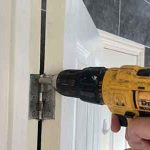Swollen doors that stick when you close and open them are quite common. However, you may have noticed a door in your home that only sticks during the winter, but then works perfectly well when the weather is warmer and dryer in Spring, Summer, and even Autumn.
So why do internal doors often swell in winter and start to stick?
The reason is quite simple, homes tend to have higher relative humidity during the winter months, compared with warmer months. This is mainly due to less air circulation throughout the property.
Most people will keep windows and doors closed during winter to keep the heat in. However, this stops moisture in the air escaping. The result is higher levels of humidity in the air. This excess moisture can be absorbed by your wooden internal doors causing them to swell slightly.
This can often be reduced in winter by using something like a dehumidifier to divert the moisture away from your door. You can see an example of a good dehumidifier by clicking here

Most internal doors will only have a few mm gap between the door and the casing, so it doesn’t take much for the door to start sticking once it begins to absorb moisture and swell.
Generally, you will find that a door sticks in one particular place. This usually means that when the door was hung there was a slight difference in the size of the gap. The discrepancy could be a small belly or bow in the frame, or perhaps the door was not planed 100% evenly.
These small discrepancies would be hard to notice when the gap is bigger and the door is fitted, but when the door swells, this area will be the first to reach the door casing and start to stick.
How can you stop doors from sticking in winter?
There are several ways you can stop your doors from sticking in winter. These are things you can do when you originally hang the door, as well as solutions to fix your door right now.
We will start with the solutions to fix a door that is sticking right now.
Check the hinges
OK, this step has nothing to do with your door swelling. However, you will be surprised how many times loose screws are the culprit to a door sticking.
To check this simply open the door slightly, and then gently push on the latch side at the top and bottom. If you notice movement near the hinges the screws are loose.
Often simply tightening the screws will fix the problem, with that said, you may benefit from adding 1 or 2 slightly bigger or thicker screws to get a better grab. This will stop the hinge becoming loose again in the future.
Check the gap around the door
If the door is sticking due to swelling, the issue will often be isolated to one or two places. This could be anywhere around the door, but it will usually be in one of the following places.
- Top, bottom, or both, on the latch side of the door.
- Somewhere in the middle of the latch side of the door.
- The top of the door.
If the issue is on the hinge side, this won’t cause sticking, instead, this will cause your door to bind and have problems closing. This is a completely different issue, although the solution is the same.
To stop the door sticking, you will need to even out the gap. To do this, close the door and mark the area that needs removing to make it fit.
You should try to make the mark match the existing gap. Our goal here is to plane away the area that is sticking and create a completely even gap around the door.
Once you are satisfied that your mark is even with the current gap, you can use a surface plane to shave the door to the line you marked. Ensure you wind the blade in and only remove a small amount at a time.
If you’re planing at the corners, you should avoid planing towards the corner. Instead plane from the corner into the door. This will avoid spelching (blowing out) the corner.
Also, if you are planing small areas in the corners or on top of the door, you may benefit by switching to a block plane, rather than a smoothing plane.
Once you have planed away the discrepancy, your door should close into the opening with an even gap.
Hanging your door so it never swells
There are two main ways to avoid future sticking when you first hang a door.
- The first is quite simple, hang it well first time. This means ensure that the gap around the door is completely even. A good way to do this, is by using a packer or a coin to check the gap.
For example, in the UK, you might run a pound coin around the entire door, this gives a pretty good-sized gap. If at any point your coin sticks, take a little more off in that area. This will ensure if the door does swell lit swells evenly, making it less likely areas will stick in the future. - Paint or stain every side and surface of the door. The reason doors swell is moisture gets in, to avoid this, don’t give it a way to enter the door.
Make sure you fully seal the door and don’t neglect areas such as the top and bottom. As well as the hinges and where locks and handles have been cut out.
You will often find doors in high moisture areas are most at risk. A good example, which is very common, is your bathroom door. In many cases it will start to stick, because the door is not planed evenly, and it has not been sealed with paint or stain on the bottom.
I have seen this exact scenario many times over the years. Therefore, once your door fits, take the extra time to seal it. This should minimise any future swelling and avoid this problem happening altogether.
Conclusion
As you can see, the reason doors swell in winter is due to excess moisture being absorbed. Thankfully, this is quite easy to fix, and after reading this article you should know how to avoid it in the future.
One final tip to minimise the risk of swelling even further is reduce humidity. This is actually not that difficult. Just open a window and let some fresh air circulate in and allow the moisture to escape. This alone will significantly reduce moisture in the air.
If it is really cold, you could consider adding extractor fans in high moisture areas, such as bathrooms and kitchens. Alternatively invest in a dehumidifier. This is a cheap and effective solution to reducing moisture in the home. You can see an example of a good dehumidifier by clicking here




